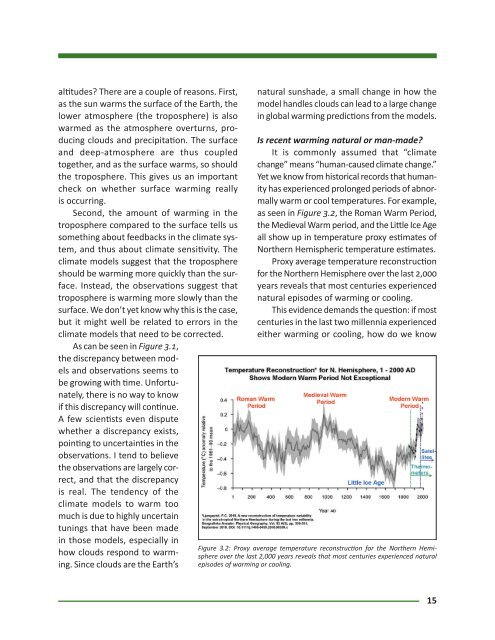The Climate Surprise
The-Climate-Surprise_CO2C-New-Criterion-1
The-Climate-Surprise_CO2C-New-Criterion-1
You also want an ePaper? Increase the reach of your titles
YUMPU automatically turns print PDFs into web optimized ePapers that Google loves.
altudes? <strong>The</strong>re are a couple of reasons. First,<br />
as the sun warms the surface of the Earth, the<br />
lower atmosphere (the troposphere) is also<br />
warmed as the atmosphere overturns, producing<br />
clouds and precipitaon. <strong>The</strong> surface<br />
and deep-atmosphere are thus coupled<br />
together, and as the surface warms, so should<br />
the troposphere. This gives us an important<br />
check on whether surface warming really<br />
is occurring.<br />
Second, the amount of warming in the<br />
troposphere compared to the surface tells us<br />
something about feedbacks in the climate system,<br />
and thus about climate sensivity. <strong>The</strong><br />
climate models suggest that the troposphere<br />
should be warming more quickly than the surface.<br />
Instead, the observaons suggest that<br />
troposphere is warming more slowly than the<br />
surface. We don’t yet know why this is the case,<br />
but it might well be related to errors in the<br />
climate models that need to be corrected.<br />
As can be seen in Figure .,<br />
the discrepancy between models<br />
and observaons seems to<br />
be growing with me. Unfortunately,<br />
there is no way to know<br />
if this discrepancy will connue.<br />
A few sciensts even dispute<br />
whether a discrepancy exists,<br />
poinng to uncertaines in the<br />
observaons. I tend to believe<br />
the observaons are largely correct,<br />
and that the discrepancy<br />
is real. <strong>The</strong> tendency of the<br />
climate models to warm too<br />
much is due to highly uncertain<br />
tunings that have been made<br />
in those models, especially in<br />
how clouds respond to warming.<br />
Since clouds are the Earth’s<br />
natural sunshade, a small change in how the<br />
model handles clouds can lead to a large change<br />
in global warming predicons from the models.<br />
Is recent warming natural or man-made?<br />
It is commonly assumed that “climate<br />
change” means “human-caused climate change.”<br />
Yet we know from historical records that humanity<br />
has experienced prolonged periods of abnormally<br />
warm or cool temperatures. For example,<br />
as seen in Figure ., the Roman Warm Period,<br />
the Medieval Warm period, and the Lile Ice Age<br />
all show up in temperature proxy esmates of<br />
Northern Hemispheric temperature esmates.<br />
Proxy average temperature reconstrucon<br />
for the Northern Hemisphere over the last ,<br />
years reveals that most centuries experienced<br />
natural episodes of warming or cooling.<br />
This evidence demands the queson: if most<br />
centuries in the last two millennia experienced<br />
either warming or cooling, how do we know<br />
Figure 3.2: Proxy average temperature reconstrucon for the Northern Hemisphere<br />
over the last 2,000 years reveals that most centuries experienced natural<br />
episodes of warming or cooling.<br />
15


